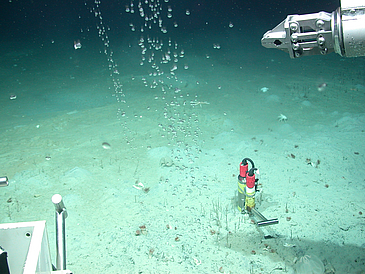Investigations have shown that earthquakes play a greater role in triggering the release of greenhouse gasses than previously thought. A new study published in Nature Geoscience online on 28th July 2013 reports on the findings of an international research team who investigated the aftermath of an earthquake measuring 8.1 on the Richter Scale that occurred off the coast of Pakistan in 1945. It is estimated that the quake caused some seven million cubic meters of methane gas to be released from the sea bed. In 2007, sixty-two years after the earthquake, researchers recovered sediment core samples from the ocean floor where the earthquake occurred. One of the core samples taken from the ocean floor contains methane hydrate, an ice-like compound comprising methane and water. Analysis of the core sample reveals that there is obviously a connection between the 1945-quake and the methane emissions.
The team of researchers from the University of Bremen‘s MARUM, the Alfred Wegener Institute in Bremerhaven, and the ETH Zurich put forward two arguments to support their findings: Unusual sulfate profiles are an indication that substantial flows of methane gas rose to the surface from deeper layers of the sea bed. In addition to this, accumulations of the mineral barite were found. Analyses of these two indices give reason to believe that between 1916 und 1962 some sort of mechanism must have triggered the increased flow of methane in the sea bed. Geoscientific evidence revealed that an earthquake measuring 8.1 on the Richter Scale had occurred in the region in 1945. David Fischer explains what then happened: “Closer investigation of this quake led us to believe that it caused fissures and cracks in the sea bed, enabling the methane previously trapped in the methane-hydrate layers to rise onto the waters above”.
Conservative estimates indicate that some 7.4 million cubic meters of methane have been released into the ocean since the quake occurred – and this doesn’t include the amounts of methane released in the immediate aftermath of the earthquake. Fischer believes other parts of the North Indian Ocean must have been similarly affected by the 1945-quake.
The recently published Nature Geoscience study sheds light on a previously little-understood natural mechanism, by means of which greenhouse gasses are released from the ocean floor. “Not until all the sources are fully known will it be possible to make more accurate predictions concerning the global carbon regime”, says David Fischer. “The Intergovernmental Panel on Climate Change (IPCC) is trying to identify all possible sources of greenhouse gasses entering the atmosphere. We hope our research efforts will contribute to this knowledge.”
Information on the topic of methane
Methane, a compound comprising hydrogen and carbon, is one of the most potent greenhouse gasses since it absorbs more of the infrared rays reflected from the earth’s surface than carbon dioxide does – and this in spite of the fact that its concentrations in the atmosphere are less dense than carbon dioxide (CO2). Large amounts of methane are present in the ocean bed in the form of methane hydrates. This ice-like substance only remains stable when submitted to high pressure under the weight of the ocean waters above and in certain low-temperature zones. Given these two conditions, the hydrates prevent the methane from flowing out into the ocean and, quite possibly, into the atmosphere as well.
For further information / interviews / photos, please contact:
Universität Bremen
MARUM Public Relations
Albert Gerdes
Phone: 0421 – 218-65540
email: agerdesprotect me ?!marumprotect me ?!.de
www.marum.de
https://twitter.com/marum_de

